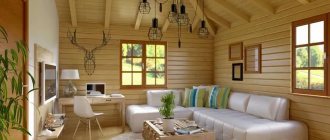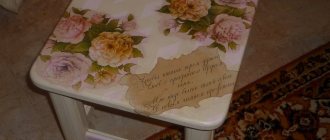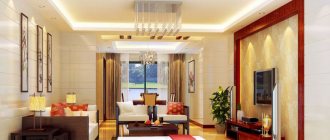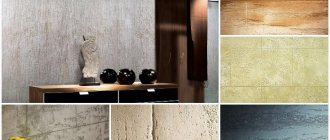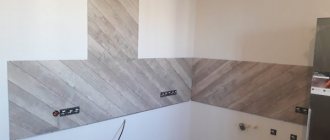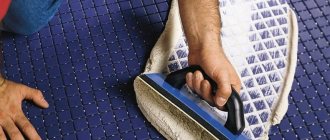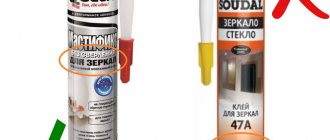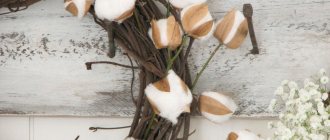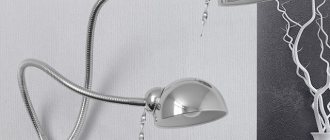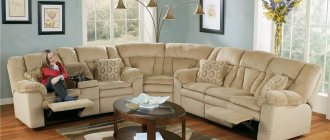The interior decoration of a country house must be durable, safe and durable. And if in winter it is empty and not heated, then it is also moisture resistant, since the risk of condensation in this case is very high. Not every material can cope with such tasks, however, if you properly process and decorate natural wood lining, it will last for decades.
Depending on how you paint the lining inside your country house, it will have a different appearance: it will retain its natural pattern and shade or take on a new one. And protective compounds for impregnating wood improve its performance characteristics.
Lining in the design of a country house
Types of lining
Thin planed boards for surface cladding are made from various materials. The most popular and durable is deciduous and coniferous wood. Plastic and MDF are also used. There are two main types of lining on the market - classic and euro. They can be distinguished by visual inspection. Depending on the required profile shape, thickness, structure, you can select a tongue and groove board from numerous subtypes. The most popular varieties are:
- "Calm". A brushed board does not have a chamfer near the tenon. When installed between the profiles, the connecting seams are invisible. The boards are thick and create an imitation of timber. Can be used for cladding facades;
- Classic. The face of a flat board has an additional round or angular chamfer. Thanks to this feature, clearly visible seams are formed during cladding;
- Block house. The front part is completely rounded. After assembly, it seems as if the walls were assembled from rounded logs. Used in saunas and baths;
- Lound House. The surface is smooth with a complex pattern. The effect is achieved through additional processing (hot stamping, milling);
- American. Simulates siding panels. The cone-shaped lamella has a chamfer at the tenon. Used for interior decoration;
- Double-sided. Has two working sides. Due to its small thickness, it is recommended to use only for indoor partitions. There are no compensation channels;
According to the processing method, wooden lining is divided into grades - “extra”, “A”, “B”, “C”. You can distinguish them visually. The slightest knots and cracks are unacceptable on the front side of the premium class board. Class “A” accepts wood without rot, blue stains, or resin pockets. Light healthy knots are possible. In grade "B" resin pockets are allowed. The cheapest grade “C” allows for blueness and wane on the back.
Different rooms one approach
Correctly selected colors look harmonious in the interior
Warm colors include light tones and shades of light beige, yellow and light brown.
So:
- How to paint the lining in the kitchen, and what color, keep it in one color or combine it with several shades. In the kitchen, selections in the form of panels are common, in which the lower part is decorated with a darker shade and the top with a light shade. Painting tape with small brushes, multi-colored paints and the imagination of the owners turns boring work into an interesting, creative process.
- If plastic products are chosen for the internal lining, then the problem of painting the plastic lining or not should not be considered. Plastic lining is available in a rich range of colors, with a perfectly smooth surface, so there is no need to fence your garden.
- Apartment owners often turn the balcony into a living space, insulating and covering the surface with clapboard. Country housing is expanding its borders, and these are arranged gazebos, verandas, and appropriate finishing is needed everywhere.
- If you don’t want to think about how to paint the lining on the veranda or inside the balcony, you can contact a specialized store. Employees will perform all operations such as antiseptic treatment, UV glazing and even varnishing. All that remains is to use it for its intended purpose on the balcony, veranda, because the varnish will not allow moisture to be absorbed into the wood.
- It is much easier to cope with internal tasks, but there is also lining outside buildings, what to do with it?
- Processing the lining on the outside is not very different from working on the inside, and the preparatory work is very similar.
- The surface of the facade is cleaned of dust and dirt. Decorative elements from the platbands and shutters are removed.
- Heavily contaminated areas are treated with special compounds against various harmful microorganisms.
- Cracks, seams, joints are sealed.
- The lining is carefully processed and dried.
The surfaces are on different sides of the building, but the approach to painting is the same and pursues specific goals. Wood must be protected from precipitation and become resistant to high humidity.
The lining should not fade or crack, rot or mold. After painting, the tree is not affected by wood borers, insects, bark beetles, and receives UV protection.
If all these signs are present, then we can assume that the final positive result has been obtained.
Advantages and disadvantages of painting lining
Painting the lining with enamel or colorless varnish can extend the life of the material. If the board is used for covering walls and work surfaces in a utility room, you can get by with regular impregnation. In a house or apartment, it is better to paint wood paneling with high-quality paint for practical and decorative purposes. After all, replacing a damaged top layer of wood is much more expensive than several cans of enamel. You can purchase a ready-made painted board or paint it yourself. Coating panels with your own hands has many advantages:
- Possibility of coloring elements in different colors, applying your own design, texture;
- Saving money. Treated lining is much more expensive;
- Possibility to choose the most incredible shade;
- Increasing resistance to negative external factors;
- Quick drying.
It is necessary to paint the lining before installation. During the normal drying process, there will be no light streaks at the joints that spoil the entire look.
There are practically no disadvantages to painting lining. The main negative point is the loss of the natural pattern and appearance of the wood. Some negative consequences can be avoided if you take into account the purpose of the room when choosing a paint and varnish material. Oil impregnation and drying oil are not suitable for baths and saunas. It is better to use solid mixtures with the addition of wax. It is not recommended to use flammable, toxic enamels for painting wooden boards in closed, unventilated areas. Painting lining floors should be carried out taking into account the abrasion of the material. To avoid having to repaint frequently, you should choose mixtures with high wear resistance.
Photo ideas
Polar color - painting brushed wood in two layers - Exclusivewood.rf
11. We paint the lining with oil brushing with our own hands!
Solutions used for coloring
There are many means for covering lining. These are compositions for internal and external cladding of premises. They differ in composition, speed and quality characteristics. For example, a wooden exterior façade is affected by ultraviolet rays, moisture, high and low temperatures, so the finishing coating should contain the predominant majority of protective components.
You can decorate the lining of the interior of the house with ordinary enamels and paints. Painted natural boards have an original appearance. Each mixture after painting gives a certain effect to standard lining. The choice of solution depends on the preferences of the owner of a country or city building.
Protective agents: properties and application technology
Proper and timely use of protective equipment allows natural lining not to lose its appearance and original structure for many years. Antiseptic agents can increase the moisture resistance and durability of the material. The solutions also prevent damage by insects, various microorganisms, and the formation of mold, which is detrimental not only to the lining, but also to the health of the dacha owners. Based on the basis of manufacture, antiseptics are divided into four main groups:
- Organic solvents. They penetrate deep into the material, destroy areas of rot and mold, and prevent the appearance of new ones. Actively combat biological pollution. They have a pungent odor. Can be used indoors and outdoors;
- Water-soluble products. Temporarily protect wood in contact with moisture. Used for preventive purposes;
- Oil antiseptics. It is recommended to treat lining that is in the open air in contact with the ground with moisture. Effectively protect material in difficult conditions;
- Combined mixtures. The solutions contain various substances. Inherent in each group. They cope well with mold, moisture, and high temperatures. Can be used for both internal and external processing.
To reduce the negative impact on the lining, various solutions are used. Bioprotective compounds successfully fight pests, mold, and mildew. Fire retardants provide fire protection and slow down the spread of fire. Complex protective agents – biopyrenes – are used as a base coating. To bleach wood, you can use chlorine-containing mixtures, hydrogen peroxide, and special industrial liquids. Lining made from low grades of wood must be treated with primer to fill the pores.
The lining is covered with protective agents before varnishing and decorative treatment. The application technology consists of impregnating each fragment separately and on both sides. Using a brush or roller, spread the antiseptic over the entire surface in a thin layer. It is necessary to reach all hidden areas (corners, recesses). Wooden boards should dry without touching each other.
Varnish compositions and their properties
To refresh the antiseptic-impregnated lining and refine the finish, the wood is varnished. The required composition of the solution is selected based on the type and purpose of the room.
Oil-based resin varnishes can have different shades - from transparent to dark chocolate. The coating hardens quickly, forming a dense film. The moisture-resistant surface is easy to clean and is completely ready for further painting. The main disadvantage is the high level of fire hazard.
Alkyd universal solutions have a high level of resistance to external negative factors. They are absorbed deep into the wood, so they take a long time to dry (up to 3 days). Alkyd-urea varnishes have almost identical characteristics. Before use, the solution must be mixed with an acid hardener. It has a strong shine after hardening. Disadvantage: high price, rapid ignition.
Alcohol polishes and varnishes are used in minimal quantities to coat individual elements of the lining. Apply a very thin layer of solution using a cotton swab or small brush. The dried coating noticeably shines and gains elasticity. Some types of alcohol mixtures do not tolerate sunlight, so they cannot be used on large areas of the lining.
The composition of nitrocellulose varnishes includes plasticizers, resins, and pigment. After application to wood, they form a dense protective and decorative coating. They do not cover lining intended for finishing facades. Nitrovarnish does not tolerate sunlight. High temperature.
Water-based polyurethane and acrylic solutions are applied to the lining in several layers due to the high volatility of the mixture. They have surface tension properties and do not crack or wear off. The varnish adheres tightly to the wood, protects it from chemicals and getting wet.
Paints in different compositions for coating wooden lining
A wide variety of decorative mixtures allows you to choose the most extraordinary solutions to implement bold design ideas. With the help of paint and varnish products, you can give the lining absolutely any color and texture. The following paints can be used for interior decoration of a country house:
- Acrylate. Resistant to precipitation, retains shine and color for a long time. The paint has good adhesion and wears out slowly;
- Oily. It is well absorbed into the lining, does not allow moisture to pass through, and allows the material to breathe. May fade over time;
- Water-based. Preserves the wood texture and gives a matte finish. The paint dries quickly and has no odor;
- Silicone. Withstands impressive mechanical loads. It has good vapor permeability and masks defects. Retains color for 30 years;
- Alkyd-based enamel. Suitable for decorating lining. During prolonged drying, it emits a pungent, unpleasant odor. Fades quickly in the sun;
- Wax. Traditional, natural material for processing lining. After painting, it retains the natural pattern of wood, gives a matte, glossy shine;
- Silicate. The composition includes liquid glass, which significantly improves the characteristics of the paint. She is not afraid of ultraviolet rays. A dye with increased fire resistance protects the lining from temperature changes.
Ideas
In a modern interior it is very difficult to find a place for classic lining with a light fiber texture. Most often it will look like a tree trunk torn out of the forest and brought straight into the house. You need to choose a finishing method and create the desired decorative effect so that the interior looks as harmonious as possible (read more about where lining is used and how to sheathe walls inside and outside with it, and find out how to beautifully sheathe walls and ceilings with wooden boards in a separate material).
There are several interesting ideas for painting wooden panels:
- Alternate combination of different tones of coloring compositions, panels of various thicknesses and widths.
- Multi-profile panels can be combined into an interesting relief.
- The placement of spotlights in different areas of the cladding creates incredible lighting effects that significantly transform the appearance of the lining.
- The use of several colors of paints or varnishes in the same color range, but different in saturation and tone. This will allow you to emphasize some areas and zoning the space.
- Painting on a wooden surface looks very original and natural.
- Bleached canvases create a feeling of spaciousness and a more noble interior.
Important It is important not to overdo it, not to turn the room into a color blot. It is necessary to adhere to a harmonious combination of colors and their saturation.
How to calculate the required amount of paint
Any repair or construction must begin with an estimate and detailed instructions. Consumables, such as paint for lining, must be purchased in reserve. When making calculations, one should take into account the characteristics of the surface, tools, professionalism of the work performers, the number of layers and the texture of the mixture.
If the entire room is to be painted, then first of all it is necessary to determine its perimeter. We take away the area of doors, windows, openings and other untreated surfaces. The result obtained must be compared with the standard consumption of the selected type of paint. Manufacturers place this information on the product label. You need to understand that the quantity is indicated taking into account the work under ideal conditions, for one layer of painting.
Materials for interior painting
When selecting the necessary tool, it is necessary to take into account that before painting the surface must be treated with anti-rot compounds. With this in mind, you should stock up on the following materials:
- Coarse sandpaper to clean the surface from dirt and foreign matter. This is especially necessary for lower grade linings, the technical conditions for which require the presence of resin pockets - if they are not cleaned out, the painting will not be of high quality.
- Set of painting tools. In addition to the traditional flat brush, you also need a wool roller, a bucket, and a spray gun/spray gun. For tall rooms, a stepladder may also be required.
- Safety glasses and a gauze bandage - if it is impossible to work in a well-ventilated area.
- For priming and antiseptic treatment, it is better to have a separate set of painting supplies, since it is not known in advance how dissimilar coatings will interact with each other.
Lining painting technology
Factory-painted lining elements cost several times more than untreated boards. The services of hired workers will also not be cheap. To save money, you can carry out all stages of coating yourself. Fortunately, this is not difficult to do. Properly selected consumables and auxiliary materials will enliven the interior and fill the house with new colors.
The application of enamel should be carried out after antiseptic procedures, priming and varnishing. When working with any mixture, certain rules must be followed. Only in this case can you count on a positive result.
Required materials and tools
Even a beginner can paint lining well. It's better to work with new material. It is quite simple to prepare, process and dry. The task becomes more difficult if the boards have already been used and the toning needs to be updated. Only clean lining can be repainted. The method of removing varnished coating is the same for all types of wood. It is better to bleach pine and larch in warm and ventilated areas. Painting wooden panels is carried out using a minimal set of tools and materials. You need to prepare:
- Paint tray;
- Galvanized, plastic bucket;
- Brushes for applying paint of different sizes, roller, spray gun;
- A ladder that allows you to reach the ceiling;
- Solutions for painting (stain, varnish, enamel, primer);
- Tools for stripping, grinding, rubbing (sandpaper, leather flaps, sanding machine and others);
- Wide safety glasses, mask, gloves.
What is better to paint
To apply paint to the lining, you can use a brush, spray gun or roller. Choosing the right tool will make the process much easier. For a small area, you can use a wide brush. In this case, the paint should be moderately thick so that there are no noticeable marks from the strokes. This material can be used to add color to both individual boards and the assembled structure.
It is better to use a roller for covering eurolining and other types of boards with a smooth surface, with unpronounced seams. You can take a wide tool that grabs two boards at once. This will speed up the process and reduce paint consumption.
When using a household spray gun, you must prepare for high consumption of water emulsion. In order for the paint to be better absorbed into the wood, the solution should be made very liquid. With this technology, leaks and layers are inevitable. It is necessary to strictly maintain the distance between injections to avoid the formation of drops.
Drying and moisture level of the lining
Only high-quality, dry wood can be used for cladding. Wet lining will certainly spread and crack some time after installation. You can determine the degree of humidity at home using the traditional method. The weight of a dry board is significantly different from a wet one. A mechanical pencil will not leave a purple streak on dry paneling. The sound of dry wood will be louder.
You can resort to traditional methods if you have comparative wet material at hand. If there is nothing to compare with, you can use a mechanical method of verification. It is necessary to drill a hole in the wood to be tested. Hold the cutter in one position for 20 seconds. Visual analysis of the excavation will indicate the approximate moisture content. The hole began to smoke - the board was overdried, nothing happened - the humidity was normal, a fringe formed - the lumber was damp. The lining must be dried under a canopy in the open air for several months.
It is necessary to thoroughly dry the lining after each treatment (impregnation, priming, varnishing, painting). If these are separate boards, they should be placed in a ventilated area or taken outside in warm weather until completely dry. The hardening time for each solution used is individually calculated by the manufacturer. The drying time may increase if the paint is applied in several layers.
Preparatory stages
Proper preparation of the lining for painting makes it easier to work with the material in the future. New dried boards should be cleaned of dirt. If it is very dusty, you can use a damp cloth and baking soda. Then it is necessary to eliminate all defects. The wood is sanded with pumice or fine sandpaper. Small particles are removed and primer is applied.
If the lining has already been used, preparatory work includes mandatory cleaning of the old coating. Paint and old varnish are removed with solvents. Multilayer dried materials are removed with a metal brush, hairdryer, or construction spatula.
If in the future the old lining will be covered with transparent varnish, then it is better to use a mechanical cleaning method. Solvents and removers can whiten the surface unevenly.
Applying paint
It is easier to paint wooden lining before its installation. The solution should be applied in a thin layer, slowly moving from top to bottom. If a brush is chosen for work, it should have semi-stiff bristles. To avoid streaks, do not put a lot of paint on the brush.
The roller should have medium-length pile. After dipping it in paint and rolling it along the tray, the tool is pressed against the paneling with moderate force and rolled several times. There should be no voids or smudges on the surface. If the boards have already been assembled, their edges must be painted with a brush. Painting with a spray gun will be faster, but some of the paint will scatter onto nearby objects.
Chemical cleaning
The simplest and most reliable way to remove contaminants is to use liquid chemical compounds. They are evenly applied to the surface to be treated according to the instructions, and after a while they are washed off along with the dirt. Highly concentrated preparations contain alkaline components that promote rapid removal of soot from surfaces without damaging the wood structure.
To quickly clean walls and floors, you can use a mop with a telescopic handle.
No less effective in the fight against soot are chemical sponges impregnated with deep penetration substances. They contribute to the quick and safe removal of the smallest particles of soot and soot that have penetrated the wood structure.
The principle of working with sponges is quite simple: holding the sponge with one hand, clean the surface from top to bottom.
Finally, it is recommended to wash the cleaned surface with clean water and wipe dry with a soft cloth. This is done as follows: the floor is covered with film or oilcloth to protect the surface from further contamination.
Next, clean water is poured into the container, to which a detergent composition, for example, for washing dishes, or any other degreasing agent is added. The soot is washed off with smooth movements using a soft sponge.
Painting with brushing of lining
A non-standard solution will give the wood an aged, aristocratic look. You can create this effect using a drill with a special attachment – a brushed ball. When processing the surface, depressions are formed, which, when painted, appear as an unusual pattern. Its depth can be adjusted by passing the ball.
You can use dark or light oils to paint the board. Apply the coating using the “dry brush” method using a thick sponge and rub evenly over the surface. The first layer dries for 2 hours. Then light oil or paint is applied. After 15 minutes, remove with a rubber spatula, pressing it well to the surface. After drying, the wood will get an interesting aged effect.
Painting wood while maintaining texture
Painting the lining and maintaining the wood texture is very simple. For this purpose, varnish, pigmented oils and glazes are used. Work can be carried out on separate boards or already on a sheathed wall. Use a roller and several brushes of different sizes.
Texturing technology involves applying dispersion varnish with a brush to small fragments of material and then evenly distributing it. Use a roller for spreading. It is necessary to move strictly along natural furrows. After 10 minutes, remove excess mixture. The varnish remains in the grooves, making the design bright and shiny.
How to paint lining like bleached oak
You can achieve the effect of bleached oak and preserve the natural beauty of the tree using frost stain, white oak stain, transparent wax oil, polyurethane, or bleached acrylic pigment.
First of all, apply the tint in a thin layer. Then cover with oil. The thickness of application depends on the expected result. If you need a clearly defined pattern, remove the excess and wipe the surface with a rag. You can whiten wood using a primer. But it is worth considering that on some breeds it will turn yellow over time. For example, pine material can be whitened with regular gray wood paint.
Carrying out the procedure
To paint wooden panels, paint or varnish with colors and dyes of different types and compositions is used (how to properly varnish a panel for a long time?). Application techniques and finishing methods depend on the composition of the paintwork material.
Varnish
To paint wooden panels with varnish you will need:
- check all existing lining, sort it by color and quality, exclude panels that contain falling knots or other obvious defects;
- thorough sanding is carried out until absolutely smooth to the touch is achieved;
- if necessary, cover with a special primer or apply the first base layer of varnish, leave each canvas to dry without touching the treated surface;
- if an opaque varnish is used, then repeated sanding over the painted layer is necessary;
- A second layer of varnish is applied until the color is uniform over the entire area of the canvas, and then dried.
Tip Rejected panels can be used as test panels. On them you can see the type of coating with different numbers of layers, etc.
You can watch how to properly varnish the lining, what tools and techniques to use for this, in the following video:
Dyeing white
To create the desired decorative effect, several coloring techniques are available:
- Acrylic pigment primer diluted to 80-100% is applied like a regular varnish. It creates a coating with a long service life, but its price is high.
- Polyurethane pigment primer labeled “bleached” or “white” with a dilution of up to 80-100% also provides the desired decorative effect, but over time the color becomes yellow.
- Oil with wax - with a single-layer coating requires rubbing with a rag to preserve the wood texture; with a two-layer finish the surface is opaque.
- Tinting or staining - often found with the markings “bleached oak”, “frost” and the like. The peculiarity of the finishing is a multi-layer coating with very thin and uniform films. Otherwise, a peeling effect will form on the surface.
These methods provide different shades of white, depending most on the type of wood.
You can learn how to quickly and correctly paint the lining white from this video:
Aging effect
You can make the interior of a room attractive and original by artificially aging finishing materials. Natural lining without coating looks monotonous. You can add antique value to it in several ways:
- Brushing. Suitable for pine or oak. The top layer of the rock is removed with a coarse brush, sanded and covered with stain of any color, for example, wenge;
- Pantination. Use two colors of paint, slightly different shades. The first enamel is applied in a thick layer and allowed to dry. Then paint a thin layer of lighter paint. After complete drying, rub the surface with sandpaper. The illusion of numerous repainting of the lining is created;
- Paraffin treatment. Wax is applied unevenly to individual areas. Then the pantining process is repeated. After drying, remove it with a spatula and treat the board with stain. The result is a worn effect.
Ideas for painting lining in the interior of an apartment/house
In the interior of city apartments, painted lining is practically never found. Natural material will take root well on loggias and balconies. The style solutions of country houses, on the contrary, will be complemented by a natural zest when using wooden profiles.
The combination of lining of different thicknesses looks unusual. A wide profile is alternated with a thin one and painted. They are painted in one color, but in different intensities. Depressions and waves are formed from smooth profiles and block houses. The lighting areas are whitened, the remaining areas are simply coated with clear varnish.
The bleached lining on the ceiling, located between dark massive beams, looks original. In the bedroom, living room, nursery, you can create an exclusive wall covering, paint the wood in any bright color, or paint it with patterns.
Color palette
The choice of color when painting lining is determined by the style of the interior, its color scheme, as well as the taste of the owners of the house.
Not everyone likes a light and smooth surface. Some people will want to add brightness to the interior, while others, on the contrary, will want to shade it with dark splashes. Some will emphasize the structure of natural wood, while others will decide to hide it completely. All this is a matter of taste.
Often when painting lining, white is used. Whitewashed wood, especially oak, creates a special atmosphere in the house. Light shades visually expand the space, “lift” it, add air and spaciousness. Therefore, rooms with a small area are most often decorated in light colors.
Combined with the structure of the wood, the effect is truly magnificent. Such a surface will fit into any style; it will harmonize with almost any environment and color. Translucent paint that does not hide, but emphasizes the wooden texture and gives a white tint to the material itself is a good option for slightly refreshing and updating the interior without drastic changes.
To create a bright color accent, you can use acrylic or oil paints. They offer a fairly wide selection of shades - from discreet muted to flashy bright ones.
Another option for adding color to the lining is the use of tints. They can be added to water-based paint, glaze, and obtain a variety of shades of any degree of saturation. By properly mixing several tones, you can get a rather interesting complex shade that will fit perfectly into a given interior. But in order not to spoil all the base paint (to which the colors will be added), it is better to pour a little into a separate container and try there.
In general, painted lining itself creates an interesting effect in the interior, especially when the structure of the wood remains clearly visible. It is not for nothing that such a solution is increasingly found in a variety of designs, in different colors and in different styles.
